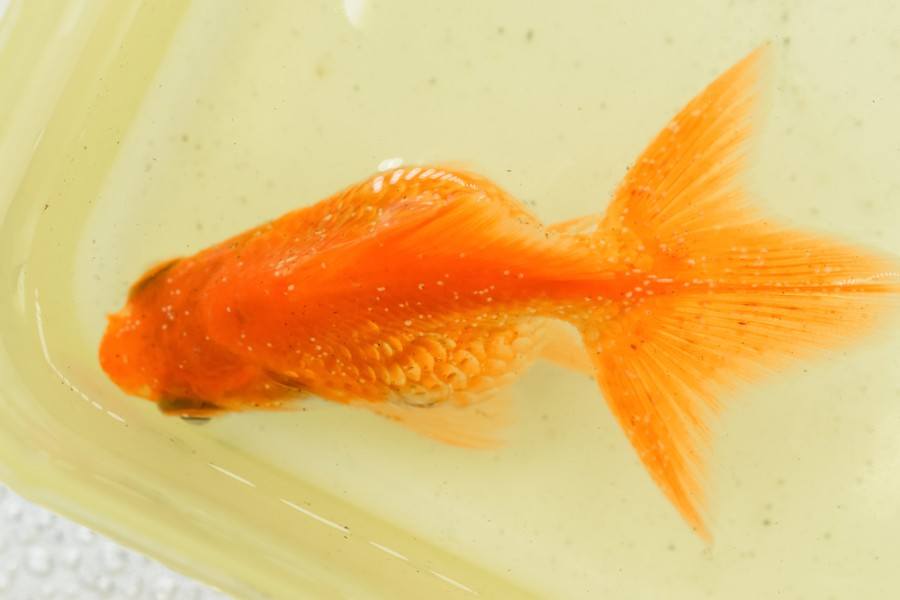How to Dispose of a Dead Goldfish: 5 Step Process

Updated on

We’re sorry you’re here today because the circumstances that brought you to this page are so sad. That said: Death is part of life, one we all face at one time or another.
So we wrote this guide hoping it will make the process as simple as possible for you when you need to dispose of a dead fish. This is a kind, safe, respectful method where we’ve broken down each step.
We hope it helps you! Keep reading to learn how.
The 5 Steps to Dispose of a Dead Goldfish
1. Remove the Dead Fish From the Aquarium.

(And as soon as possible.)
If there are other fish in the tank, the longer the dead fish remains in the aquarium, the more dangerous the polluted waters are and the greater the risk of infection to the others if the fish died of illness. The risk is even greater if the other fish start eating the dead one.
Using a fish net (or your hands if it doesn’t bother you), remove the fish from the tank and place it in a paper bag. Also, Your net or hands will need to be thoroughly washed and sterilized afterward to prevent contamination of your other fish.
2. Place the Fish in a Paper Bag.

Sometimes it can be really hard to look at your fish once they are dead, and it can make you feel just terrible. A paper bag really helps with this in my experience. It also makes it easier to transport your deceased pet.
3. Place the Bagged Fish in the Freezer.
This will preserve their body until you are ready to bury them. Freezing the fish gives you some time to get everything planned out: the burial site, what to bury them in, and other details.
Tip: If the fish is very large, you may wish to place the paper bag holding the fish in an old ice cream container to prevent water from making a mess.
4. Bury Your Fish (Don’t Flush).
If you loved your pet fish and they were a meaningful part of your life, we highly recommend burying your fish instead of throwing them fish in the trash along with a bunch of other unwanted garbage.
There’s a way to give our precious friends a more dignified passing than that. Flushing a dead fish is not only not respectful…It is illegal in the US.
Introducing non-native fish, dead or alive, into the waterways can transmit bacteria and disease to other animals. So, what do you do with a dead fish?
You can honor the influence they had in your life by giving them a proper burial. For those who want to do something extra special, you can obtain a special environmentally friendly casket made specifically for fish.
It’s also a good way to teach children about the cycle of life and death while helping to bring a sense of closure to them through the process. Here’s a quick tip:
Your fish should be buried at least 3 feet deep in the ground to prevent wild animals, dogs, or cats from breaking into the box. Some people also like to put a paving slab (blocks diggers) or bag of kitty litter (masks the scent) on top of the casket to deter unwanted animals as well.
Now, where should you bury your dead fish? It’s totally up to you (as long as it is on your property). A popular choice is in a garden beside the flowering plants, shrubs, or under a tree.
Interestingly enough, the decomposing fish actually becomes fertilizer for the plants. Holding a mini “funeral service” for your late fish might be something you would like to try.
These folks got creative:
5. Create a Special Monument.
This step is optional, but many people like to do it. One way to help ease the pain and honor the memory of your pet is to create a monument at the site where you buried them.
Memorial stones block diggers and mark where you placed your fish so you can visit the site later. It’s a beautiful way you can show them your love one last time. The engraved kind is made to last with time and weather.
Protective Measures
After you have kindly disposed of your pet from the tank, you will now want to do a large water change to remove the toxins (mostly ammonia) that were put out by the corpse. This will help protect the tank’s other inhabitants.
A filter cleaning and a gravel vacuum are probably a good idea as well, in addition to a probiotic bacteria supplement to help fend off bad bacteria that have been introduced to the water.
The worst thing that can happen is to have your other fish pass in succession as a result of exposure to the other one.
Conclusion
It can be devastating to lose a pet, but knowing what to do can help make the process a little easier. We hope you found this article useful. What is your experience dealing with a deceased fish? Do you have any tips you’d like to share? Feel free to leave a comment below!
Featured Image Credit: TDesigns, Pixabay












